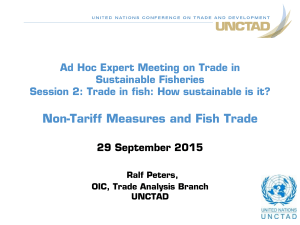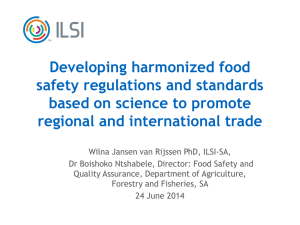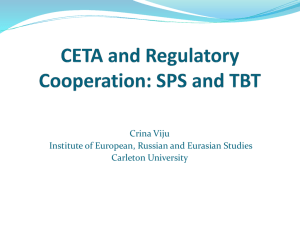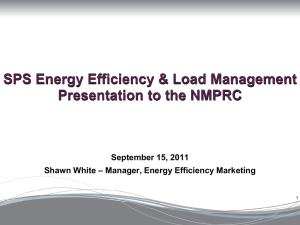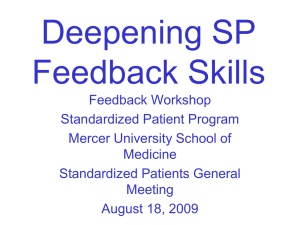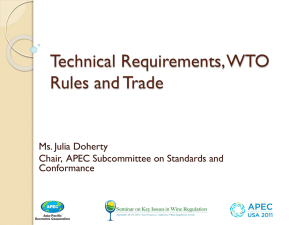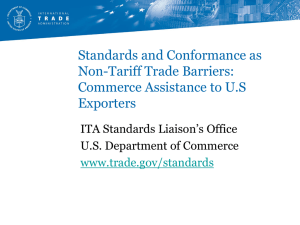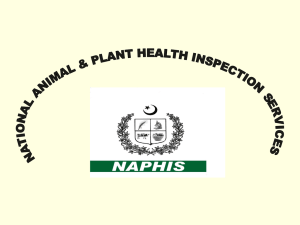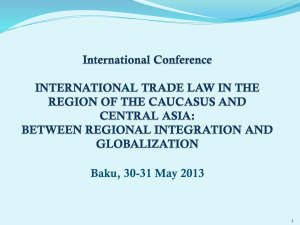Tamanna Chaturvedi, Consultant, Indian Institute of Foreign Trade
advertisement
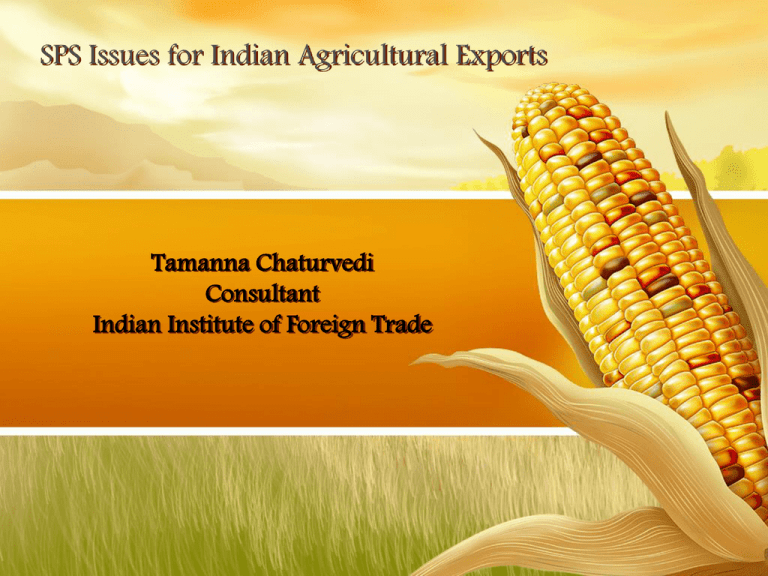
SPS Issues for Indian Agricultural Exports Tamanna Chaturvedi Consultant Indian Institute of Foreign Trade % ? 1947 2009 Two Way Dilemma How do you ensure that the country’s consumers are being supplied food safe to eat? How can you ensure strict health & safety regulations are not being used as an excuse for protecting domestic producers? WTO Agreement on Sanitary and Phyto Sanitary Measures WTO Agreement on Sanitary and Phyto Sanitary Measures SPS stands for Sanitary & Phytosanitary Measures The right to protect human, animal or plant life or health Avoiding unnecessary barriers to trade SPS or TBT ? SPS Measures human or animal health from food-borne risks human health from animal- or plant-carried diseases animals and plants from pests or diseases examples: pesticide residues food additives TBT Measures human disease control (unless it’s food safety) nutritional claims food packaging and quality examples: labelling (unless related to food safety) pesticide handling seat belts Harmonization Article 3 Standard-setting organizations food safety CODEX animal health plant health OIE IPPC Codex = Joint FAO/WHO Codex Alimentarius Commission OIE = World Organization for Animal Health IPPC = International Plant Protection Convention (FAO) Member Countries are encouraged to use International standards. It allows countries to set their own standards On what basis?? Scientific Justification To what extent??? Should be applied only to the extent necessary to protect Equal Treatment?? Non Discrimination Key Provisions of SPS Agreement 1. 2. 3. 4. 5. 6. 7. Non-discrimination Scientific justification • harmonization • risk assessment • consistency • least trade-restrictiveness Equivalence Regionalization Transparency Technical assistance/special treatment Control, inspection and approval procedures Scientific justification Article 2.2 based on scientific principles Members shall ensure that any SPS measure is: applied only to the extent necessary to protect human, animal or plant life or health (least trade restrictive) not maintained without sufficient scientific evidence except as provided for in Article 5.7 Scientific Justification Articles 3 & 5 Measures must be based on Risk assessment OR International Standards How is risk assessment done? • SPS measures to be based on assessment of risks to human, animal or plant life or health, taking into account risk assessment techniques developed by international organizations. available scientific evidences; process and production methods; inspection & sampling methods; prevalence of specified disease or pests; existence of pests/disease-free areas,etc relevant economic factors & cost effectiveness of alternate approaches • Avoid arbitrary/unjustifiable distinctions in the levels in different situations if these result in disguised restrictions Exception: Provisional measures Article 5.7 Members may provisionally adopt SPS measures when relevant scientific information is insufficient on the basis of available information In such circumstances, Members shall seeks to obtain additional information to assess risk review the measure within a reasonable period of time Non-discrimination Article 2.3 No unjustifiable discrimination – between Members with similar conditions – between own territory and other Members SPS permits Members to impose different sanitary and phytosanitary requirements on food, animal or plant products sources from different countries, provided that they "do not arbitrarily or unjustifiably discriminate between countries where identical or similar conditions prevail". Equivalence If the exporting country objectively demonstrates that its measures achieve the same ALOP as the importing country Members shall Accept SPS measures of other Members as equivalent Equivalence of Phytosanitary Measures Examples of Phytosanitary Equivalence • Alternative treatments of wood packaging material Nº 15) (ISPM • Phytosanitary measures to mitigate risks of fruit flies (pest free areas, area of low pest prevalence, pest free places of production, treatments, risk mitigation systems, inspection) Disease free areas Article 6 • Adaptation of SPS measures to regional conditions, including pest- or disease- free areas, differing climatic conditions & different pest or diseases or food safety conditions so as to lead to the development/imposition of different SPS requirements • Exporter to demonstrate (reasonable access to be given for inspection/testing) Transparency Article 7 & Annex B Members shall establish an Enquiry Point AND designate a Notification Authority notify other Members of new or changed SPS regulations when no international standard exists OR the new regulation is different than the international standard AND regulation may have significant effect on trade When to notify? Regular measures When modifications are still possible (draft text) Allow 60 day comment period!! Emergency measures IMMEDIATELY!! Transparency timeline Min. 6 months 9. Entry into force of the regulation 8. Publication of the regulation 7. Adoption of the regulation 6. End of comment period ...Time... Min. 60 days 5. Receive & discuss comments 4. Draft text upon request (or website) 3. Notification to other Members 2. Publication of a notice 1. Drafting of the regulation Special & Differential Treatment and Technical Assistance Articles 9 & 10 Members... • ...shall take account of the special needs of developing countries • ...should accord longer time frames for compliance • ...agree to facilitate provision of Technical Assistance India’s Concern Tariff and Non Tariff barriers For Herbal exports MFN range Switzerland 0-0 Japan 0-10 USA 0-6 NTM% NTM Description 50% Labelling requirement Product ch.requirement to protect 8.60% human health 60% Authorization to protect plant health Our target destinations Code Description Major Export Destinations 030613 Frozen Shrimps & Prawn United States, Japan, United Kingdom,Belgium 030614 Frozen Crabs Japan, USA, UK, Spain 030619 Frozen others USA, Japan, China, Singapore 030379 Fish with bones frozen China, Hongkong,South Korea, Singapore 080132 Shelled Cashewnuts USA, Netherlands,UK, UAE 080121 Brazilnuts in shelled Spain, UK, Italy 080450 Gauava & Mango UAE 080300 Banana UAE, Nepal, Saudi Arabia 160520 Shrimps & Prawn Japan, USA 160540 Other crustaceans China, UAE 200110 Cucumber & gherkins USA, Spain 200190 Vegetable pp by Vinegar UAE, Saudi Arabia 200310 Mushrooms USA, Netherlands 200830 Citrus fruit UK NTM Coverage and Number of NTMs on Indian Exports 1. 2. Fish & Fish Preparations Fruits & Vegetables Markets with 100% SPS/TBT Markets with less than 50% SPS/TBT USA, Hong Kong, Singapore, Thailand, Australia, Canada, Switzerland, Japan Thailand, Malaysia, Japan Australia, Japan, USA, Saudi Arabia, Mexico, Bangladesh, Singapore, Canada, Egypt - Markets with more than 1 SPS/TBT USA, Japan Australia, Japan, Mexico, USA, Singapore Analysis… • Widespread use of SPS/TBT both by developed & developing country markets. • In major importing countries of Fruits and marine products, NTM coverage is 100%. • Single product faces number of SPS standards in the same market.e.g. USA& Japan for fish and Australia, Japan, USA, Mexico & Singapore for fruits. • Single product faces different import standards in different markets. • Countries have different health standards for imports as against domestic production. Tariffs and NTMs on Indian Exports (i) Tariffs and NTMs together imposed on Oilseeds in Taiwan Cane Sugar in Bangladesh Bovine meat in Egypt Crustaceans in Thailand Malt extract in USA Bangladesh (ii) Only NTMs Pepper in Canada Rice in Nigeria Oilseeds in USA, Taiwan Cane sugar in Malaysia, Indonesia Fish products in USA Tea in USA Understanding Technical regulations Incidence of product withdrawals Rapid Alert Notifications from EU FOR Indian Products Complete ban from India Plant Conditions Any plant of the following genera: Ananas Citrus Ipomoea Every such plant shall be grown in Quarantine until the Director is Satisfied that it is free from plant pests and may be released or that it Is diseased and must be destroyed. Musa Groundnut and any other plant of the genus Arachis May only be imported as Decorticated seeds. Rice and any other plant of the genus Oryza intended for propagation Every consignment shall on importation be immediately handed to the Director who shall cause the plant to be grown in quarantine For one generation. Complexities of buyer’s requirement Maximum levels for Aflatoxins in spices in various developed countries Comparison of CODEX level with Country standards for Fruits GRAPES CODEX U.S.A. EU AZINPHOS-METHYL 1.0 5.0 1.0 ALPHA-CYPERMETHRIN 0.5 0.5 BENALAXYL 0.2 0.2 CARBARYL 5.0 CHLOROTHALONIL JAPAN 2.0 CANADA AUSTRALIA NEW ZEALAND 5.0 2.0 2.0 0.5 0.05 0.1 0.5 0.5 3.0 1.0 5.0 5.0 3.0 0.5 3.0 0.5 0.1 10.0 5.0 CHLORPYRIFOS 0.5 0.5 1.0 0.1 1.0 1.0 DIMETHOATE 1.0 0.1 5.0 2.0 DITHIANON 3.0 0.1 2.0 2.0 ENDOSULFAN 1.0 2.0 0.5 1.0 2.0 2.0 FENARIMOL 0.3 0.2 0.3 1.0 0.1 0.1 0.1 IPRODIONE 10.0 60.0 10.0 25.0 5.0 20.0 10.0 MALDISON 8.0 8.0 0.5 8.0 8.0 8.0 8.0 METALAXYL 1.0 2.0 1.0 1.0 1.0 2.0 MYCLOBUTANIL 1.0 1.0 1.0 1.0 1.0 1.0 0.2 PERMETHRIN 2.0 0.05 5.0 2.0 PROCYMIDONE 5.0 5.0 5.0 5.0 1.0 2.0 TRIADIMENOL 2.0 1.0 2.0 0.5 0.1 0.5 10.0 1.0 Better off than CODEX 0.02 0.5 5.0 More stringent than CODEX Countries varies in their SPS standards-case of Salmonella Importing Country Regulations regarding Salmonella Hong Kong Japan Products may be subjected to lab examination or microbiological contamination & positive testing shipment refused entry Japanese Min of health reserves the right to test shipments China No separate Salmonella specific requirements Canada No separate Salmonella specific requirements for raw products Korea No separate Salmonella specific requirements Estonia Mechanically deboned meat is tested for salmonella at port of entry Positive testing denied entry Salmonella widely present in domestic supply chains in USA however country claims to have has zero tolerance for the pathogen Different Operative Procedures for Conformity Requirements for Fruits Importing Country Australia USA EU Regulations regarding Fruits Strict attention to plant health(fumigation only using methyl bromide) Strong official attention to product cleanliness, labeling for allergens & fumigation banned out. In contrast Fumigation is already banned in EU v Spain Importance to testing on pesticide residue v Germany Hardly any consignment tested v UK Most pesticide residue testing is undertaken for products at retail level Customers of South Europe prefer large sizes of tropical fruits (pineapples, papayas & mango) whereas customers in North Europe prefer small fruits. Traceability Requirements Different Marketing Standards between countries • Health control: food law, hygiene, microbiological criteria, contaminants, pesticides • Plant Health: phytosanitary control • Marketing Standards: generic or specific • Other: food additives, food contact material, food irradiation, novel foods, GMOs, labeling & organic products Imports prohibited on the basis of Risk Assessment Incompatible SPS Standards: case of Milk Production in India Strict Packaging requirement Strict Certification & Import Procedures: example of China • Many regulations and requirements are updated frequently and often without prior notice. • Possibility of variation in the documentation required for various products in various Chinese ports. • A new and original phytosanitary certificate must accompany each consignment of fresh fruits, vegetables, or tree nuts. • A tamper-resistant, bilingual label should be on the outside of each carton. • The establishment number should be printed on the inner poly liner, poly bag, or vacuum bag. • Although pre-approval is not mandatory, China’s General Administration of Customs (GAC) can require pre-import analysis if warranted. Strict Labeling Requirements • A large amount of information has to be provided on the label in both English & Chinese. • The establishment number should be printed on the inner poly liner, poly bag, or vacuum bag. • In the case of Alcohol & Pre-packaged food – Labeling should be in Chinese. – Specific font sizes have to be maintained. • In the case of milk & milk products – Labeling should be in Chinese. – Specific background colors have also been mentioned. Few examples…. Let’s see what Pakistan has to ask for? Food quality and safety control Code of practice EUREP-GAP quality control by packing Produce Quality control selection packagin g HACCP Packing station Exporter Governme ntal SPS / Vet control quality control temp check Temperature and humidity check Point of departure Governme ntal SPS / Vet control quality control MRL control Control of compliance with code of practices Transport Point of entry Control of compliance with BRC Importer Retailer Private specifications / protocols Private specifications / protocols Micro costs of EurepGap compliance Main Products Affected 31 (+ 2) disputes have invoked the SPS Agreement Agreed Solution (7) 21% Report(s) Adopted (9) 27% Consultations - Pending (13) 40% Panel Established (4) 12% Equivalence Agreements status of India India is seeking equivalence agreements with the health authorities of major trading partners. • The EIC has already been designated a competent authority by the European Commission (EC) for marine products and basmati rice and by the U.S. for black pepper. • Similar recognition awaited from the EC for egg, milk, and poultry products. • Equivalence agreements with Australia for marine products • SriLanka for 86 items. • It is negotiating an agreement in various sectors with Singapore and will soon have an agreement with Italy. http://www.fao.org/es/esn/food/foodandfood_fruits_en.stm www.ipfsaph.org 1. General Policies which have no or minimal production or trade distortion effects Should not involve transfers from consumers or provide price support to producers. 2. Government service programmes research pest and disease control training services extension and advisory services inspection services 3. Environmental programmes Related to fulfillment of specific conditions including production methods or inputs under government programmes. Payment limited to increased costs or income loss due to compliance with the programme 4. Regional assistance Producers must be in disadvantaged regions Compensate for loss of income or extra costs in undertaking production Contract Farming examples: • Tomato cultivation in Punjab, Haryana and Rajasthan, Mushrooms in Haryana, Sunflower in Andhra Pradesh and Karnataka, Gherkins in Karnataka Fruits and vegetables in Tamil Nadu, Maharashtra and Andhra Pradesh. Other efforts • • • • • Amul & NDDB for milk procurement Sugarcane cooperatives in Maharashtra, Green leaf satellite out growers to the South Indian tea manufacturing industry, Prawn aqua culture farmers of AP & Poultry projects in West Bengal, Tamilnadu, Maharashtra, Andhra Pradesh & Punjab. Tamanna Chaturvedi tchaturvedi@iift.ac.in +91-11-26967558
